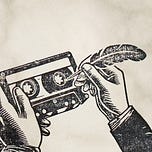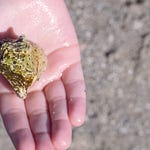Way back and before when battles were born, “Gilded” they called me and great was my power. I was steadied with spears and slain by the gods; Three times they burned me yet thrice was reborn. Some may have said that they’ve seen me thereafter, Calling me “Shining” when coming to households. Sometimes they spoke of a staff in my hand, Moving dark magic I mastered and played Among wicked women who welcome me still. For most I’m a memory a mote of the past And scarcely a shadow but shadows still speak.
The Voluspa. The “Prophecy of the Seeress.” Or, if you like, Norse Revelations.
The most well-known poem of all the Poetic Edda.
At the start, we find Odin speaking with a great and legendary völva to extract secrets about Ragnarok. At this point, Odin’s already been burdened with the knowledge of the future, and like Leonard Cohen warns, brother, it is murder. So, he continues to scour hillside and seascape for anything that might help him turn the tide once the world starts to upend itself. He doesn’t take in wisdom from just anywhere, though—he only seeks credible sources. That’s why in this encounter, he first tests the völva to determine her credibility.
Turns out she has her bona fides. She describes to Odin the “nine in the tree,” the worlds that form the very roots of Yggdrassil. She then recounts how the Aesir created the dwarves, with Durinn being among them. (“Gandalfr” is mentioned later on.)
After she proves herself, she lays out in front of the ravengod precisely what he can expect at Ragnarok—what happens to whom and in what order: Who lives, who dies and how, what the world will look like after it unfolds itself. It’s hair-raising stuff.
One of the things I love about the Voluspa is that it doesn’t matter if you’re a Norse mythology scholar or you vaguely recognize the names Thor and Loki; the poem is still, after so many centuries, accessible and mysterious to anyone who reads it.
The short poem above is my own version of one of the weirder asides in the narrative.1 The seeress mentions someone never again mentioned in surviving stories or manuscripts: “Gullveig,” whose name means something like “gold-drink,” was “steadied with spears” in the first battle of the world. Then, in Odin’s hall, they burned her three times, and she was reborn three times. From there, it gets even stranger.
There’s a lot of speculation about who this Gullveig might be. Is she Freya? Is she another goddess entirely, or a seer like the narrator? Is she both? There’s even speculation about how much of her tale pertains to her, and how much might refer to someone else.
I’ve no definitive answers for you, but before I get to some suggestions, we first have to calibrate our imaginations.
In the Greek pantheon, deities are a kind of personification: there’s a god of war who’s responsible for conflict, a goddess of the hunt, etc.
The Norse gods are not like this. Ask anyone today what Thor is known for, and if you chose “god of thunder,” then you’d win the Family Feud. Ask anyone why he’s called this, however, and you’ll likely get unsatisfying responses. That’s because although Thor’s hammer and chariot can bring the thunder when he wishes, it’s also something the sky does on its own. It’s not Thor’s “job” to supply the rumbles in the clouds.
Norse gods and goddesses are more like a cast of characters than they are immortal personifications. They’re more like people with powers. Further, the “giants” in these stories are not tall or huge, as modern depictions would have you believe. They’re merely other characters who, unlike Odin, don’t side with humanity and its survival. They’re gods who sided differently; they aren’t titans.
Anyway, as Odin would tell you, gifts don’t come without sacrifices. In our story, we find that after Gullveig survives her trials in Odin’s hall, she darkens doorsteps and danehalls to practice seið, a kind of divination magic known and practiced only by women. Freya is said to have first taught seið to Odin, so some see a connection between the two. Freya also has a thing for bling, and so some believe she very well fits the description of this “gold-drunk” magic practitioner.
I personally believe we’re going to have a very hard time navigating these stories if we insist on viewing them as moderns do. That’s not how myths work, after all, and they were never seen in such terms by the cultures that birthed them. In the way that myths are, they sing more than they’ll ever explain.
I’m not a translator—I’d much rather see myths be given new life in our own time and tongue than argue over what they used to mean in the past—but I owe a lot to Jackson Crawford, Carolyne Larrington and Henry Bellows. Their translations are excellent if you’d like to track them down for yourself, and much of the above I owe to their scholarship.














Share this post